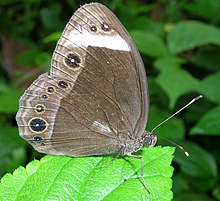Mycalesis anaxias
| White-bar bushbrown | |
|---|---|

| |
| Wet-season form | |
| Scientific classification | |
| Domain: | Eukaryota |
| Kingdom: | Animalia |
| Phylum: | Arthropoda |
| Class: | Insecta |
| Order: | Lepidoptera |
| Family: | Nymphalidae |
| Genus: | Mycalesis |
| Species: | M. anaxias
|
| Binomial name | |
| Mycalesis anaxias Evans, 1920
| |
Mycalesis anaxias, the white-bar bushbrown,
Description

Wet-season form: male and female: Upperside dull Vandyke brown, paler in the female; subterminal and terminal fine lines on both forewings and hindwings fulvescent (tawny): cilia brown. Forewing with an oblique white preapical short band not quite reaching either the costa or the termen. Underside: forewing: basal area up to the white band, and in a transverse line from lower end of band to dorsum, blackish brown; terminal margin beyond broadly paler brown; a white-centred fulvous-ringed black ocellus in interspace 2, and two preapical, smaller similar ocelli, followed by a very sinuous subterminal and a straighter terminal dark brown line. Hindwing: basal two-thirds blackish brown, terminal border broadly paler, bearing normally seven ocelli similar to those on the forewing, and subterminal and terminal dark brown lines.[3][4]
Dry-season form: Upperside as in the wet-season form. Underside differs in the ocelli being indistinct or absent, and the subterminal and terminal dark lines on both forewing and hindwing absent or very faint; the terminal margins are broadly rufescent (reddish) brown, fading inwardly into lilacine, the oblique white bar on the forewing outwardly diffuse. Antennae, head, thorax and abdomen dark brown; the antennae ochraceous towards apex.[3]
Wingspan: 51–60 mm. Male sex-mark in form 1.[3]
Gallery
-
Dry-season form at Samsing in Darjeeling district of West Bengal, India
Footnotes
- ^ ISBN 978-81-929826-4-9.
- ^ a b Savela, Markku. "Mycalesis anaxias Hewitson, 1862". Lepidoptera and Some Other Life Forms. Retrieved July 2, 2018.
- ^ a b c
 One or more of the preceding sentences incorporates text from this source, which is in the public domain: Bingham, Charles Thomas (1905). Fauna of British India. Butterflies Vol. 1. pp. 52–53.
One or more of the preceding sentences incorporates text from this source, which is in the public domain: Bingham, Charles Thomas (1905). Fauna of British India. Butterflies Vol. 1. pp. 52–53.
- ^
 One or more of the preceding sentences incorporates text from this source, which is in the public domain: Moore, Frederic (1893–1896). Lepidoptera Indica. Vol. II. London: Lovell Reeve and Co. pp. 159–160.
One or more of the preceding sentences incorporates text from this source, which is in the public domain: Moore, Frederic (1893–1896). Lepidoptera Indica. Vol. II. London: Lovell Reeve and Co. pp. 159–160.
References
- Bingham, C.T. (1905). The Fauna of British India, Including Ceylon and Burma Butterflies. Vol. 1 (1st ed.). London: Taylor and Francis, Ltd.


